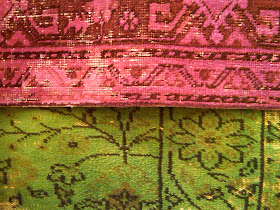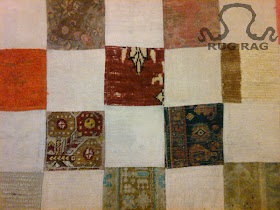Tania's publicist, Dania Ahmad, shared with me news about Tania's latest collection which is "inspired by the natural world, the way light creates shadows and reflections, the microscopic details found in nature and the infinite textures created through layering." You can imagine how intrigued I was.
As Dania explained, "Johnson creates ethereal designs and translates them into intricately woven rugs. The collectable pieces feature original, cutting-edge designs, and are hand knotted by artisans in Nepal using lustrous combinations of silk, wool and pashmina."
Can you imagine walking up such deliciousness? I can.
Tania Johnson is New York based albeit British born designer who graduated from London’s Royal College of Art with a Master of Arts in woven textiles. According to Dania, Tania Johnson "takes a hands-on approach to her business which is reflected in her commitment to promoting fair labor standards in the carpet industry. She works with GoodWeave, a certification program which aims to eliminate child labor and to improve working conditions for adults; any carpet with the GoodWeave label means that the rug was made only by adult artisans. In addition, the certification program helps fund educational opportunities for children as well as support and resources for families and weaving communities in South Asia."
My recent email exchanges with Dania focused on Tania Johnson's recent rug introductions, consisting of "four stunning hand knotted rug designs ... The earthy but contemporary patterns are inspired by intricate details of nature - among them delicate plays of light, shadows and reflection. Johnson portrays these elements through meticulous color choices, very high knot counts, and combinations of silk and wool that create nuanced textures and sheens.... As with the other designs in the collection each of these rugs - Reflected Trees, Textured Daisy, Branches, Drops of Light - is a bespoke collector's piece that pushes the boundaries of creative and technical possibilities."
Per the press release: “As an avid world traveler and photographer I have found my rug designs to serve as the perfect canvas for capturing memories from my travels. The inspiration for the patterns often comes from the subtlest details of my own photographs - rain falling on tree branches, or a close-up of a Nepalese Buddhist shrine. The colors and materials allow me to translate these small frozen moments into usable pieces of art,” said Johnson.
Furthermore, "as with the other designs in the collection each of these rugs - Reflected Trees, Textured Daisy, Branches, Drops of Light - is a bespoke collector’s piece that pushes the boundaries of creative and technical possibilities. The designs benefit from Johnson’s penchant for very low pile heights. This detail offers an added layer of luxury and a supple and sumptuous surface quality that is equally pleasing to the eye and to the touch. The entire Tania Johnson Design collection is ideal for a wide range of residential and hospitality settings – from a living room or foyer to a hotel lobby."
Go ahead, feast your eyes!
Reflected Trees – An image of trees reflected in a lake. As the sun moves across a lake, an image fleetingly appears only to be replaced moments later by a new pattern. The use of warm colors and blending of different shades with varying percentages of wool and silk in a single knot recreates the beautiful interplay of light and movement in the original photograph. Boasting a burnt orange ground, Reflected Trees is made from wool and silk. 100 knots per inch, 4mm pile.
Textured Daisy - A daisy’s shadow falls on a stony path, creating a softly blurred flower pattern on a textured ground. Subtle shades of color are finely knotted in wool to create the blurred edges while an uneven silk grid is layered on top to add movement and sheen. Textured Daisy is made from wool and silk, 200 knots per inch, 3mm pile.
Drops of Light - Light is captured as it falls in drops. Through the use of high knot count and tonal shades, the delicate nuances of light are recreated within the lemon colored wool ground, while the drops shine in silk. Drops of Light is made from wool and silk. 200 knots per inch, 3mm pile
Branches - Tree branches in the rain are viewed through a gauzy mesh. Made from pure silk, the rug gradually shifts and transforms from an intricate design to a sheen of olive green tones as one moves around it. Branches is made from 100% silk. 200 knots per inch, 4mm pile.
If you'd like to order a Tania Johnson rug, you'll be interested to know that the standard sizes for Tania Johnson Design rugs are 5'x8', 6'x9', 9'x12' and 10'x14'. At the same time, everything in the line is made to order and completely customizable - which means that you will have a field day!
You can also learn more about Tania Johnson design and her inspiration via her blog.
For many of you, I expect that you're looking to create a consistent or integrated feel in your home. And, if you're looking to meld the soft rug interpretations that Tania Johnson has created with hard surface concepts, I suggest you visit the Avente TileTalk Blog and specifically New Leaf Imprint Tiles for Spring which - in my mind - would coordinate beautifully together.
What's your take? Do you enjoy nature inspired designs in rugs as well as tile?
Special thanks to Tania Johnson and Dania Ahmad.











